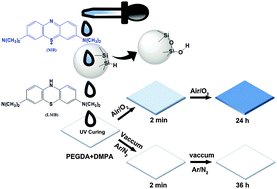Dye colour switching by hydride-terminated silicon particles and its application as an oxygen indicator†
Abstract
While various forms of silicon have been widely used in the semiconductor industry and other fields, this is the first time hydride-terminated silicon particles have been employed as a reducing agent for redox active dyes. The vivid colours of the dyes can be easily decoloured within seconds to minutes by hydride-terminated silicon particles with different sizes in the nanometer to micron size range and completely recovered to their original colours after separating the silicon particles and further exposing to air. As a comparison, other traditional reducing agents such as Na2SO3 and NaBH4, as well as the silicon particles without HF etching were also employed for the reduction–reoxidation of the dye, respectively. By making use of the colour switching property of the dye, a polymer–dye composite film was shown to function as an indicator for oxygen. This film is very sensitive to oxygen and air while remaining stable in vacuum, argon, carbon dioxide and nitrogen gas atmospheres. Oxygen indicator films with different colours can also be made by incorporating different redox active dyes in the films.


 Please wait while we load your content...
Please wait while we load your content...